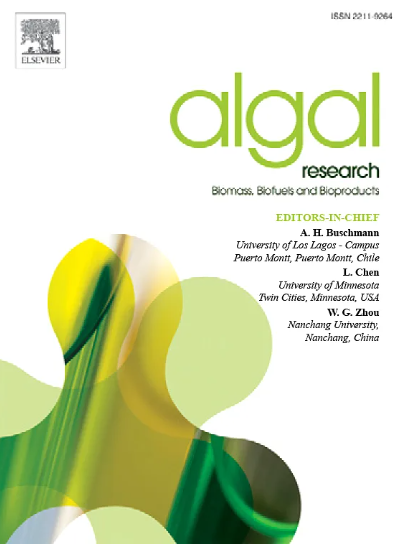Upcycling algal biomass into biodegradable materials: Enhancing structural properties and performance through hydrophobic modifications
IF 4.5
2区 生物学
Q1 BIOTECHNOLOGY & APPLIED MICROBIOLOGY
Algal Research-Biomass Biofuels and Bioproducts
Pub Date : 2025-07-01
DOI:10.1016/j.algal.2025.104175
引用次数: 0
Abstract
This study presents a sustainable approach for valorizing algal residual biomass (ARB) through its incorporation into PLA/PBAT bioplastic blends. The acetylated ARB demonstrated multifunctional properties, serving as both a nucleating agent (increasing relative crystallinity from 12.77 % to 32.30 % in PLA/PBAT 30/70 blends) and a compatibilizer (high-temperature tanδ peak vanished in PLA/PBAT 70/30 blends). Mechanical testing revealed ARB's unique plasticizing effect, particularly in PLA/PBAT (30/70) blends where it induced yield behavior and plastic deformation, increasing elongation at break from 7.24 % to 7.97 % with 25 % ARB content. The optimal 20 % ARB formulation achieved a balanced tensile strength of 6.24 MPa with 7.82 % elongation, while flexural modulus decreased from 1106.92 MPa to 200 MPa in PLA-rich blends, indicating significant system softening. Thermal analysis showed enhanced stability and improved crystallization behavior. The composites maintained excellent biodegradability (17.71 %/8 weeks) with no phytotoxicity, while reducing material costs by 14.13 %. Comparative analysis positioned ARB composites as superior to starch-based bioplastics, suggesting their potential as sustainable alternatives in bio-based plastic formulations. This work provides a practical pathway for developing cost-effective, eco-friendly bio-composites with tunable mechanical properties through ARB incorporation.

将藻类生物质升级为可生物降解材料:通过疏水修饰增强结构特性和性能
本研究提出了一种可持续的方法,通过将藻类残留生物量(ARB)纳入PLA/PBAT生物塑料混合物中。乙酰化后的ARB具有多种功能,既可以作为成核剂(PLA/PBAT 30/70共混物的相对结晶度从12.77%提高到32.30%),又可以作为相容剂(PLA/PBAT 70/30共混物的高温tanδ峰消失)。力学测试表明ARB具有独特的塑化效果,特别是在PLA/PBAT(30/70)共混物中,ARB诱导屈服行为和塑性变形,当ARB含量为25%时,断裂伸长率从7.24%提高到7.97%。当掺量为20% ARB时,拉伸强度为6.24 MPa,伸长率为7.82%,但拉伸模量从1106.92 MPa降至200 MPa,体系软化明显。热分析表明其稳定性增强,结晶行为改善。复合材料保持了良好的生物降解性(17.71% /8周),无植物毒性,同时降低了材料成本14.13%。对比分析表明,ARB复合材料优于淀粉基生物塑料,这表明它们有潜力成为生物基塑料配方的可持续替代品。这项工作为通过ARB掺入开发具有可调机械性能的经济高效、环保的生物复合材料提供了一条实用途径。
本文章由计算机程序翻译,如有差异,请以英文原文为准。
求助全文
约1分钟内获得全文
求助全文
来源期刊

Algal Research-Biomass Biofuels and Bioproducts
BIOTECHNOLOGY & APPLIED MICROBIOLOGY-
CiteScore
9.40
自引率
7.80%
发文量
332
期刊介绍:
Algal Research is an international phycology journal covering all areas of emerging technologies in algae biology, biomass production, cultivation, harvesting, extraction, bioproducts, biorefinery, engineering, and econometrics. Algae is defined to include cyanobacteria, microalgae, and protists and symbionts of interest in biotechnology. The journal publishes original research and reviews for the following scope: algal biology, including but not exclusive to: phylogeny, biodiversity, molecular traits, metabolic regulation, and genetic engineering, algal cultivation, e.g. phototrophic systems, heterotrophic systems, and mixotrophic systems, algal harvesting and extraction systems, biotechnology to convert algal biomass and components into biofuels and bioproducts, e.g., nutraceuticals, pharmaceuticals, animal feed, plastics, etc. algal products and their economic assessment
 求助内容:
求助内容: 应助结果提醒方式:
应助结果提醒方式:


